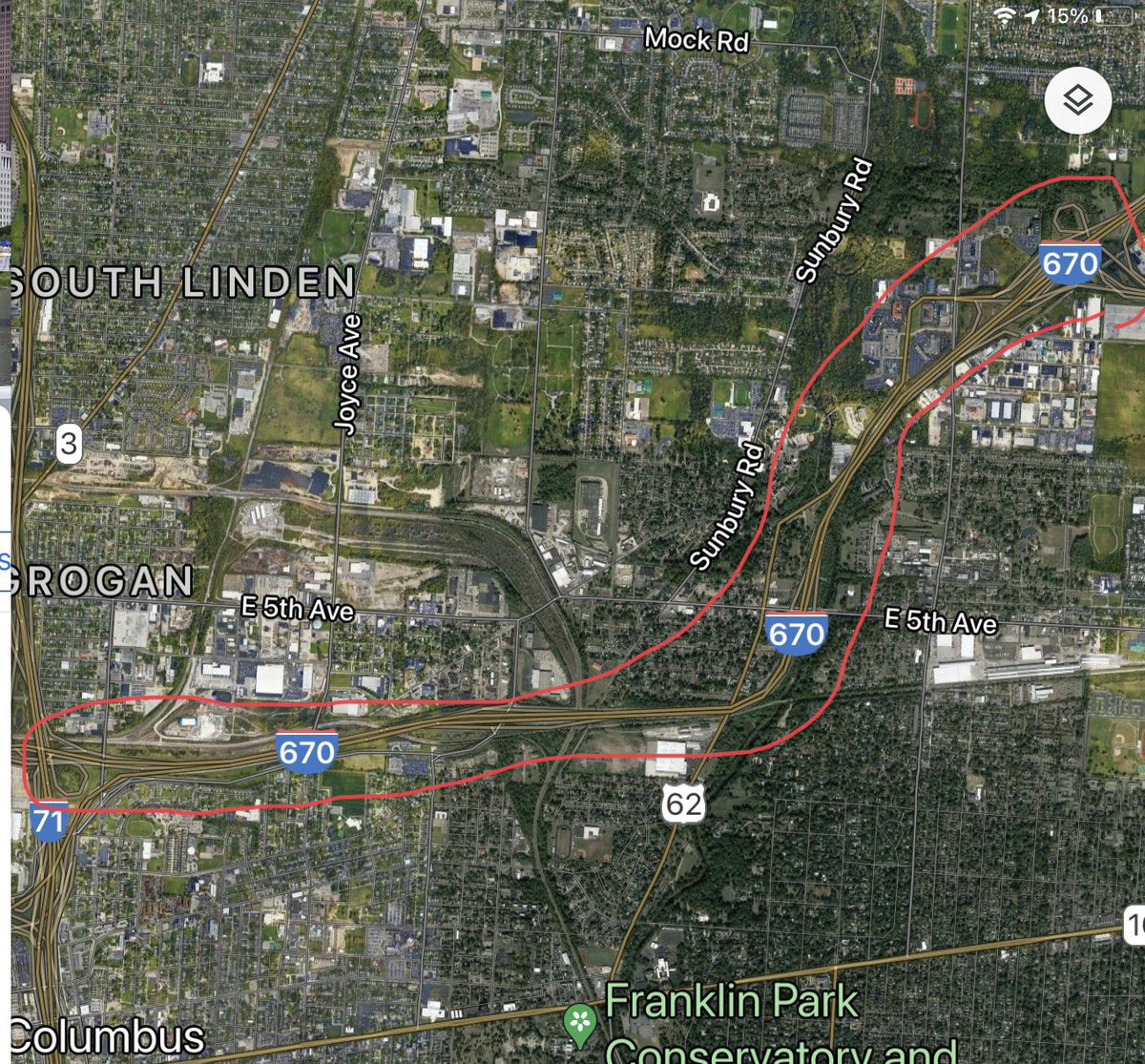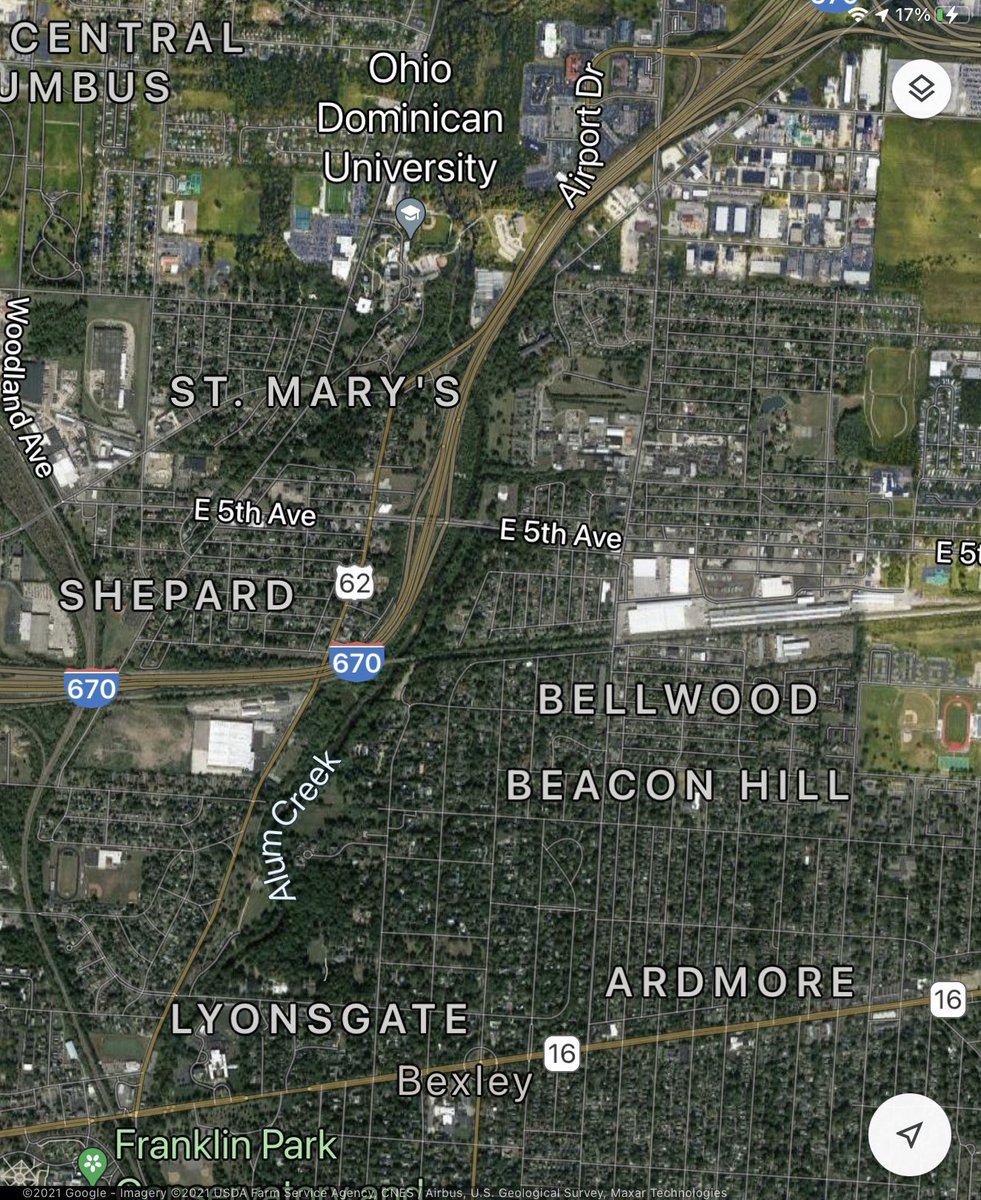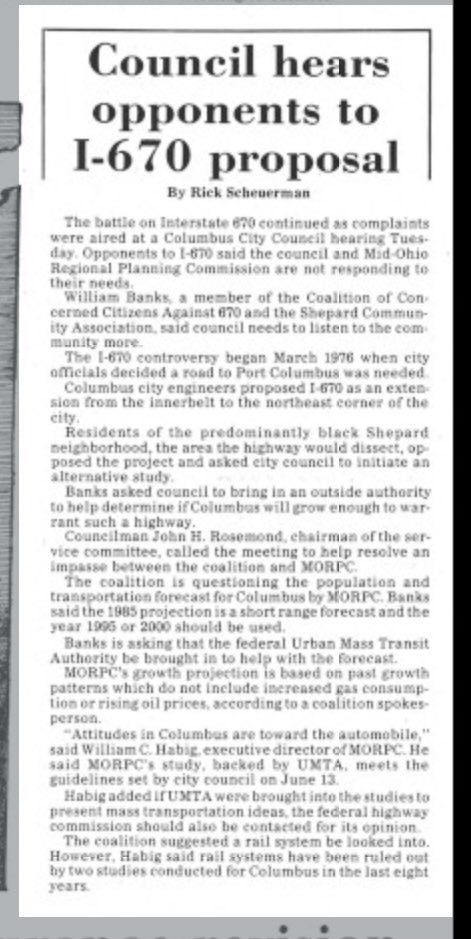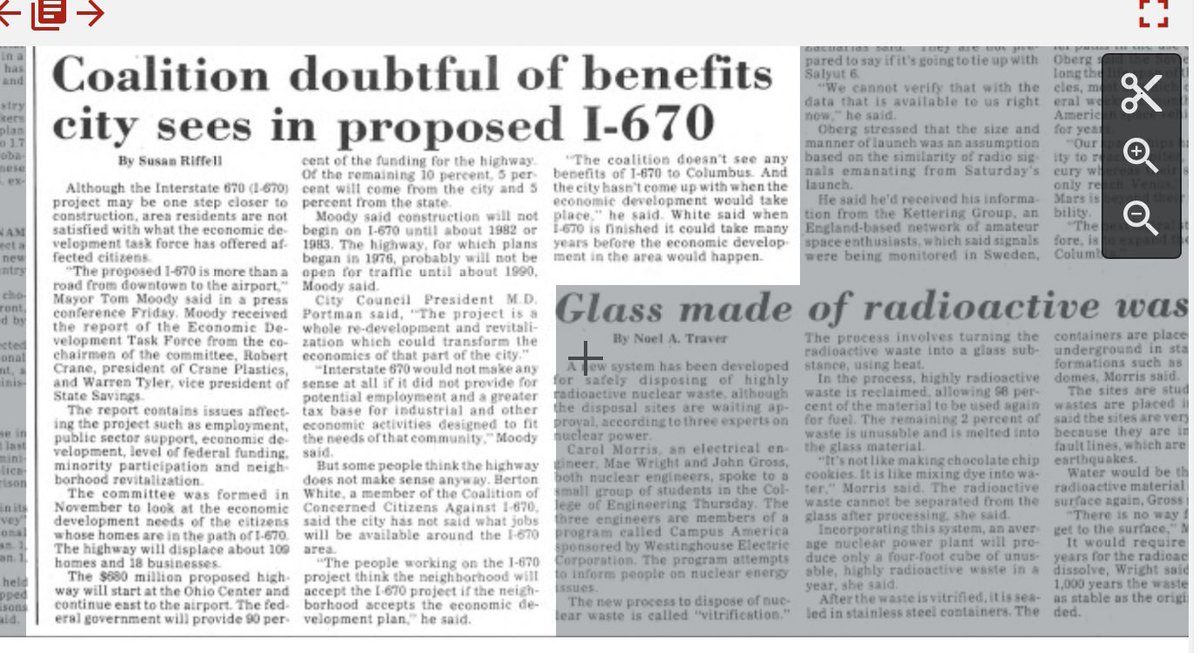For Central Ohio folks, consider the relatively recent history of the I670 construction from downtown Cbus to the airport. Take a look at the map and the neighborhoods that were sliced through to make it happen despite amazing efforts in the 1970s and 80s by community activists https://twitter.com/SecretaryPete/status/1381674012670066688">https://twitter.com/Secretary...
As apparent in the map, the neighborhoods of Mt Vernon, Milo Grogan and several others were plowed through to make way for I670, but that worst damage was done to Shepard. (More on Shepard below).
The idea of an expressway to the airport germinated in the 1950s, and grew in the 1960 until it because the darling project of MORPC in the 1970s. At the time, there was already some organic routes to CMH primarily along 17th and/or Leonard Ave that could have been upgraded.
But MORPC latched onto the idea of a dedicated 6+ mil freeway from downtown to Port Columbus. MORPC’s strategy seemed to be to leverage abandoned railway right of ways (goodbye Union Station) downtown. At best, this provided a mile or 2 of where an new interstate leg could begin.
But what about the rest of the way to the airport. Why should a few “slums” (actually long standing middle class communities that coincidentally were/are 75% Black) get in the way of progress?
The cheerleaders for the MORPC-designed project (other than MORPC)were led by then-mayor Tom Moody (later Buck Rinehart)and the banks/news/shoes titans who called the shots on all major aspects of Columbus development.
A phalanx of PR teams were sent out to sell the I670 concept to the public - and test the response in the affected neighborhoods. The response was angry, particular from the Shepard Community Association where as many as 100 homes would have to cleared.
Besides the loss of homes and displaced individuals, the SCA correctly pointed out the substantial loss of property values and the cultural/psychological effects of having this community blown apart by the behemoth roadway and its entrance ramps.
MORPC, it would appear from the record, tried to complain that all of its planning processes could have been observed by the SCA and other groups. The SCA pointed out that they probably would have - if only someone had told them that a target was being painted on their community.
Moody sniffed out this significant problem and set up a “Citizens Advisory Group” “for the purpose of receiving public comments and providing information to the public.” Although the CAG had community involvement it was primarily toothless.
Despite the CAG’s shortcomings, 2 Shepard activists - Berton White and William Banks, part of the newly formed Coalition of Concerned Citizens Against I670 - consistently attend the CAG meetings and argued (apparently correctly) that info and research was being withheld.
(I’m going to condense some of the action here - cut me some slack) White, Banks and their coalition invested significant time in developing the outlines of at least 2 credible alternatives to I670: 1) upgrade existing roadways or 2) creat a light rail system from downtown to CMH
MORPC “whipsawed” the coalition’s proposals. It argued the roadway upgrade could not handle the anticipated traffic. OTOH, there would not be enough demand for a light rail system. Banks and White unsuccessfuly argued the CAG and their coalition be given access to MORPC research.
In a moment of crystal clear honesty - extremely revealing in light of the current debate over transit infrastructure, community preservation and development - MORPC laid its biases on the table: “‘"Attitudes in Columbus are toward the automobile," said William C. Habig’”.
The mayor and city council then tried to double down on the benefits of I670 with an incredible line of BS about the vast economic and employment benefits that would rain down on Shepard and the East Side.
"’The proposed 1-670 is more than a road from downtown to the airport," Mayor Tom Moody [who] received the report of the Economic Development Task Force from the cochairmen [...] Robert Crane, president of Crane Plastics, and Warren Tyler, vice president of State Savings.’”
“The committee was formed in November to look at the economic development needs of the citizens whose homes are in the path of 1-670. The highway will displace about 109 homes and 18 businesses.”
Some residents may remember Maury “Mad Dog” Portman who jumped in with his nonsense: “‘City Council President M.D. Portman said, "The project is a whole re-development and revitalization which could transform the economics of that part of the city.’”
Back to Mayor Moody crapola: “‘Interstate 670 would not make any sense at all if it did not provide for potential employment and a greater tax base for industrial and other economic activities designed to fit the needs ofthat community,’ Moody said.”
With assistance from a real “peoples” attorney Lou Jacobs and the OSU law school, White and Bank and the Shepard coalition mounted a strong but unsuccessful challenge in federal court.
While disappointing, the decision by US Dist. Judge Joseph Kinneary is a good, easy and fairly revealing account of MORPC’s maneuvers, the city’s subterfuge and the fight waged by White and Banks. https://law.justia.com/cases/federal/district-courts/FSupp/608/110/1464644/">https://law.justia.com/cases/fed...
For me, Kinneary’s decision buried the most important fact presented in the case:
“James Gabriel, Columbus expressway engineer during the location and design phases of the I-670 Project, testified that a ‘very indirect route’ could have gone around ‘some’ of the affected neighborhoods, [...]
and that the City did not investigate or prepare cost estimates for these indirect routes.” Goddam! And that pretty much spells out the racism argument
Finally, there is a surprisingly detailed account of the whole fight laid out in a free Google Book: #v=onepage&q=berton%20white%20william%20banks%20i-670&f=false">https://books.google.com/books?id=gK01AQAAMAAJ&pg=RA6-PA15&lpg=RA6-PA15&dq=berton+white+william+banks+i-670&source=bl&ots=eUGnVyNlLf&sig=ACfU3U3eLp6uQP3wPSeZhnY-H5iYYbg9GA&hl=en&sa=X&ved=2ahUKEwjnlYii2PnvAhUFd98KHbw6BwwQ6AEwBHoECAsQAw #v=onepage&q=berton%20white%20william%20banks%20i-670&f=false">https://books.google.com/books...

 Read on Twitter
Read on Twitter





